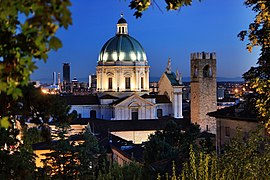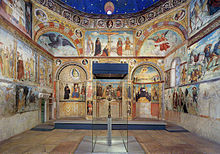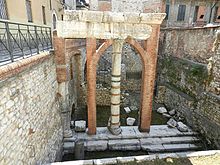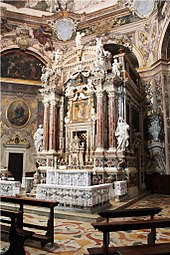Brescia
| Brescia | ||
|---|---|---|

|
|
|
| Country | Italy | |
| region | Lombardy | |
| province | Brescia (BS) | |
| Local name | Bresa / Bressa / Brèscia | |
| Coordinates | 45 ° 32 ' N , 10 ° 14' E | |
| height | 150 m slm | |
| surface | 90 km² | |
| Residents | 199,579 (Dec. 31, 2019) | |
| Population density | 2,218 inhabitants / km² | |
| Factions | North, west, center, east, south | |
| Post Code | 25100 | |
| prefix | 030 | |
| ISTAT number | 017029 | |
| Popular name | Bresciani | |
| Patron saint | Faustinus and Jovita ( February 15 ) | |
| Website | Brescia | |
 View of Brescia with the dome of the "new cathedral" |
||
Brescia [ ˈbɾɛʃːa ] ( Latin Brixia ) is an Italian city with 199,579 inhabitants (as of December 31, 2019), capital of the province of the same name , Brescia, and the second largest city in Lombardy after Milan . Its catchment area, which comprises a total of 350,000 to 500,000 inhabitants, is the third largest Italian industrial region.
The archaeological area of the Roman Forum and the monastic complex of San Salvatore-Santa Giulia belong to a group of building ensembles that were added to the list in June 2011 under the title The Lombards in Italy, Places of Power (AD 568 to 774) of the UNESCO World Heritage .
history
Antiquity
Ancient Brixia was a settlement of the Celtic tribe of the Cenomanians . It became 225 BC. BC Roman when the Cenomanians submitted to the Roman Empire. Augustus founded here in 27 BC A civil (not military) colony. During his reign, Vespasian had a large temple built in the center of Brixia as a thank you to the city's residents for their support during his candidacy for emperor. This was dedicated to a total of three deities. The archaeological area with the remains of the temple, called the Capitolium, can still be visited in Brescia today.
Longobards
After the fall of the Roman Empire , Brescia was occupied by various tribes such as Goths and Huns during the Migration Period . Only with the settlement of the Lombards under King Alboin did calm return to the city, and it was able to slowly return to its former prosperity, which was last under the Romans. The Lombards spread steadily from the north towards the south of the Italian peninsula , and Brescia became the seat of one of the 36 duchies of the Lombards Empire, whose king, however, had his headquarters in Pavia . Brescia itself produced two kings, Rotari in 636 and Desiderius in 757 , under whose regiment Brescia rose to become a major cultural center. In 753, together with his wife Ansa, he founded the monastery of San Salvatore in the heart of what was then the city center of Brescia and provided it with rich furnishings, such as the relics of Santa Giulia ( Julia of Corsica ). One of Desiderius' daughters married Charlemagne in 770, king of the Frankish Empire . Only a few years later, however, Charlemagne disowned his wife and marched with his army across the Alps towards the Longobard Empire, which was to mean the end of Longobard rule in Italy.
Carolingian
During the Carolingian era, the San Salvatore Monastery founded by Queen Ansa (now the San Salvatore-Santa Giulia Museum Complex) was the center of the city. The (lay) abbesses of the monastery came from the ruling families for a long time.
Abbesses of San Salvatore
- Anselperga; † around 781, daughter of King Desiderius and Queen Ansa, 2nd abbess of San Salvatore
- Gisela (Gisla), * probably 830; † 860, daughter of Emperor Lothar I , 851–860 abbess of San Salvatore in Brescia
- Gisela (Gisla), * probably 852/855; † before April 28, 868, 861 abbess of San Salvatore zu Brescia, daughter of Emperor Ludwig II.
- Engelberga ; † 890/891, wife of Emperor Ludwig II († 875), 868 abbess of San Salvatore in Brescia, later abbess of San Sisto in Piacenza
- Ermengarde , * probably 852/855; † 896 before June 22, daughter of Emperor Ludwig II , wife of Boso von Vienne († 887), king of Niederburgund , 878 abbess of San Salvatore in Brescia;
- Bertha; † after 952, daughter of Emperor Berengar I , 915 abbess of San Salvatore in Brescia
Communal movement
As early as the late 1130s, the communal movement led to serious disputes between the citizens and the bishop, in which the young Arnold of Brescia was also involved. From 1167 onwards, Brescia was one of the most active members of the Lombard League of Cities . In 1258 Ezzelino da Romano seized power and the Scaliger ruled until 1421. After that, Brescia fell to the Visconti from Milan and in 1426 finally to the Republic of Venice . In the early 16th century, Brescia was one of the most prosperous cities in Lombardy, but suffered long after 1512 from the sacking by Gaston de Foix .
Modern times
Much of the city was damaged in 1769 when San Nazaro Church was struck by lightning. The reason for the great damage was the explosion of 90 tons of gunpowder that had been stored in the church. About 3000 people died. The community had previously refused to install a lightning rod, as lightning was of divine origin and would not destroy a church. A lightning rod was installed in response to the explosion, but gunpowder was still stored in the church.
Brescia belonged to Venice until 1797 and then came under Austrian rule . In the spring of 1849 the city became famous because of the revolt against Austrian rule. The ten-day popular uprising led by Tito Speri began on March 23, after the city refused to pay a fine to Austrian authorities. During the fighting, the Austrian garrison fired cannons and the like. a. the cathedral , the Palazzo della Loggia, the theater and numerous private apartments. On the fourth day of the uprising, Tito Speri and volunteers defeated General Nugent's 1,000-strong reinforcement, who was advancing from Mantua and failed again the next day at the Porta di Torrelunga. On the ninth day of the uprising, Austrian troops entered the city under Julius von Haynau , who demanded an immediate unconditional surrender of the insurgents and threatened to lay the city in ruins. However, the demands for surrender were rejected by the Brescians. The Austrian General Nugent lost his life in the ensuing fighting. On the tenth day, the Austrian troops (now in the strength of a corps ) succeeded in breaking the resistance. This was followed by looting and arbitrary shootings. Brescia remained under Austrian rule for ten more years until the second Italian War of Independence .

On June 13, 1859 , Giuseppe Garibaldi and his alpine hunters entered the city after defeating the Austrians at Varese and San Fermo . The city of Brescia was nicknamed Leonessa d'Italia ("Lioness of Italy") for its struggle for freedom in the Risorgimento .
On May 28, 1974, a neo-fascist attack took place in the Piazza della Loggia , in which eight people died and 102 people were wounded.
On September 19 and 20, 1998 Pope John Paul II visited the diocese . 50,000 worshipers gathered in the Brescia Calcio stadium .
In spring 2020, Brescia was one of the regions most affected by the COVID-19 pandemic in Europe, along with Lombardy .
City tour
Measured against the abundance of buildings from antiquity, the Middle Ages, the Renaissance and the Baroque, the following tour is more of an exemplary character and presents some outstanding examples.
| The monumental area of the Roman Forum and the monastic complex of San Salvatore-Santa Giulia (The Lombards in Italy. Places of Power; 568-774 AD) |
|
|---|---|
|
UNESCO world heritage |
|
| National territory: |
|
| Type: | Culture |
| Criteria : | ii, iii, iv |
| Reference No .: | 1318 |
| UNESCO region : | Europe and North America |
| History of enrollment | |
| Enrollment: | 2011 (session 35) |
UNESCO World Heritage Sites
The following cultural monuments have been individually included in the UNESCO World Heritage List.
- Republican sanctuary (1st century BC)
- Capitoline Temple (1st century)
- Roman theater (1st century)
- Domus dell'Ortaglia (1st century)
- Basilica of San Salvatore (8th century)
- Church of Santa Maria in Solario (12th century)
- Nuns choir (16th century)
- Santa Giulia Church (16th century)
- Palazzo Maggi Gambara (16th century)
Roman center
If you look at the city map of Brescia, you can still see the streets that were laid out in Roman times and run at right angles to each other. The original Roman settlement, which was one of the most important in Roman Upper Italy, is now in the eastern part of the city. However, the area enclosed by medieval walls is larger than the city at that time. The Via dei Musei leads to the former center and a field of ruins with the expanded system of a Capitoline temple. The temple was built under Emperor Vespasian from 73 to 74 AD on the north side of the forum behind it.
Cathedral Square
Originally there were three Romanesque monumental buildings on the Cathedral Square in Brescia. As part of the baroque construction activities of the 17th century, the summer cathedral was demolished. In its place was the New Cathedral, construction of which began in 1604 and was not completed until 1825. A large dome, covered with copper plates and divided into eight segments by clearly protruding webs, with a windowed, also domed lantern , designed by the architect Marchese Luigi Cagnola , one of the leading classicists in Milan, rises above the imposing façade made of bright Botticino , a Limestone . Numerous works of art can be found in the cross-shaped interior, although not always of significant artistic importance.
The rotunda of the winter cathedral, the Duomo Vecchio, is right next to the New Cathedral. It is one of the most impressive Romanesque church buildings in Lombardy and was built in the 11th and 12th centuries. The Gothic bishop's tombs in the interior are well worth seeing; the greatest is that of Bishop Bernardo Maggi from the 13th century.
On the west side of the cathedral square is the Broletto, the government palace of the medieval city republic. It is the oldest public building that was the seat of the municipal judiciary during the communal period and the residence of the Venetian authorities from the 15th to 18th centuries. With its tall tower and the Loggia delle Grida (Loggia of Screams), the building is a classic example of a town hall from the 12th and 13th centuries. The palace has a square floor plan with a wide inner courtyard, with three of the surrounding facades dating from the Middle Ages and the portico to the north from the 17th century.
Piazza della Loggia
The most beautiful square in the city, opened in 1433, is dominated by the magnificent Renaissance building of the loggia. The new government center was planned by the Venetians in 1484 as a contrast to the medieval cathedral square. The palace, richly decorated with plastic ornaments, was started in 1492 and completed in 1570 in the upper part with the participation of the architects Jacopo Sansovino and Andrea Palladio.
On the south side of the square rise the two houses of the Monti di Pietà from the 15th and 16th centuries, in one of the outer walls of which Roman inscription stones were inserted during the construction; the ancient building is connected to the younger by a small arch to the east. A small loggia in Venetian style connects the Monti di Pietà with the ancient prison building.
In the middle of the east side of the square you can see an astronomical clock from the 16th century above the portico . The clock mechanism has been in full operation since manufacture. The hours are struck by the characteristic statues at the top of the tower, which make them i Macc dè lé ure (the madmen of the hours).
Santa Maria della Carità church
Among the many churches in the art city of Brescia, the church of Santa Maria delle Carità is a showpiece from the Baroque period of Brescia. The magnificent main altar is one of the most beautiful in the city. The origin of the building goes back to the 16th century, but the church was rebuilt in the following century (1640). With some changes during the first half of the 18th century, it was finally finished in 1825. In the second half of the 17th century, the image of the Vergine dei Terragli was placed on the main altar and a chapel similar to that of the Holy House in Loreto was added. The octagonal floor made of multi-colored marble complements the stucco work and fresco paintings on the walls, as well as the architectural perspectives of the dome.
climate
The climate of Brescia is warm-temperate, but due to its location in the interior of the Po Plain, it is continental, so that frosts can occur more frequently in winter, especially in January and February. Summers are hot, occasionally it can reach over 37 ° C.
|
Average monthly temperatures and rainfall for Brescia
Source: clisun.casaccia.enea.it ; Precipitation, rainy days: acq.isprambiente.it ; Humidity: clima.meteoam.it
|
||||||||||||||||||||||||||||||||||||||||||||||||||||||||||||||||||||||||||||||||||||||||||||||||||||||||||||||||||||||||||||||||||||||||||||||||||||||||||||||||||||||||||||||||||||||||||||||||||||||||||||||||||
politics
Emilio Del Bono ( PD ) was elected Mayor in June 2013. His center-left alliance has the majority in the municipal council with 24 out of 40 seats.
Population development

Town twinning
Sister cities of Brescia are:
-
 Bethlehem , Palestine , since 2007
Bethlehem , Palestine , since 2007 -
 Darmstadt , Germany , since 1991
Darmstadt , Germany , since 1991 -
 Logroño , Spain , since 2006
Logroño , Spain , since 2006 -
 Troyes , France , since 2015
Troyes , France , since 2015
and
traffic
Street
Brescia is connected to two Italian motorways. In the southern part of the city runs the A4 , which runs from Turin to Trieste through the Po Valley. From here the A21 branches off to Turin via Piacenza. Due to the high number of commuters and the high population density, the old streets in downtown Brescia are congested. The result is traffic jams and high pollution for the residents.
rail
The Brescia railway station has access to the railway line Milano-Venezia . There are other routes, also from the Italian State Railways, to Bergamo , Cremona and Parma . The Ferrovienord company operates a route across Lake Iseo and through the Camonica Valley to Edolo .
Due to the heavy traffic in Brescia, the city has been looking for a new concept since 1986 that should go beyond modernizing the bus routes. Of many alternatives, the construction of a subway line was eventually chosen and construction began in 2003. The metro connects the northern and southern suburbs with the old town and was opened on March 2, 2013. The route runs underground in the old town (eight stops). In the outer parts of the city the route is at ground level, on embankments or elevated (nine stops). The subway is operated automatically and has a 3-minute cycle during peak times and a 7 to 9-minute cycle at other times. The high frequency of cycles and the short distance between stops should encourage as many drivers as possible to switch to the new means of transport. Large-format information posters on the construction sites and a dedicated website promoted awareness of the project even before it was completed. Brescia is one of the smallest cities in Europe with its own metro.
In April 2018, the construction of a new tram network was also announced
air
- Brescia-Montichiari Airport is located around 15 kilometers southeast of Brescia
- Bergamo Airport is around 50 kilometers northwest of Brescia
- Verona Airport is around 60 kilometers east of Brescia
- Milan Linate Airport is around 85 kilometers west of Brescia
- Milan Malpensa Airport is around 135 kilometers west of Brescia
Sports
Automobile sport
Brescia was the start and finish of the Mille Miglia between 1927 and 1957 .
Soccer
Brescia is home to the football club Brescia Calcio , which plays in Serie A in the 2019/20 season .
fencing
The Schermabrescia fencing club has been in operation since 1984. The club's most successful athlete is the foil fencer Andrea Cassarà , who won gold in singles at the 2011 World Fencing Championships .
Specialties
Brescia is known for the Casonsei , a regional variant of the ravioli . The main components of the filling include a. Salami, spinach, eggs, chestnuts, sultanas, cheese, parsley and various spices. When serving, they are traditionally coated with a mixture of breadcrumbs, melted butter and sage.
Personalities
Famous personalities of the city are included in the list of personalities of the city of Brescia .
In the 17th century, Brescia was an important center of musical instrument making in northern Italy. Important masters were Gasparo da Salò and his student Giovanni Paolo Maggini . After the death of the great masters, Brescia was forgotten as a violin making center . The painter Francesco Filippini (1853–1895) was also born in Brescia .
literature
- Gabriele Neher : Marin Sanudo on Brescia. Caterina Cornaro's 1497 Entry and Glimpses into the Life and Politics of a Renaissance Border Town , in: Humfrey Butters, Gabriele Neher (Ed.): Warfare and Politics. Cities and Government in Renaissance Tuscany and Venice , Amsterdam University Press, Amsterdam 2020, pp. 227–240.
- Walter Pippke, Ida Leinberger: Lake Garda, Verona, Trentino ; Art guide. DuMont Buchverlag, Cologne 1998, 2nd edition 2000, ISBN 3-7701-4343-4 , p. 172.
- Guida di Brescia: La storia, l'arte, il volto della città. Mauro Bonetti: il Medioevo , Brescia 2005 p. 54.
- Touring Club Italiano: Brescia e il suo territorio. Milano 2012, p. 24 f.
- Anna Ferrari-Bravo, Paola Colombini: Guida d'Italia. Lombardia (esclusa Milano). Milano 1987, pp. 545-602, 604-605.
- Lombardia - Touring club italiano, Touring Editore (1999), ISBN 88-365-1325-5 , Brescia Online
Web links
- Brescia Tourism. Comune di Brescia, accessed on March 20, 2014 (City of Brescia Tourism Portal).
- Paesaggio Italiano. Leonardo Bellotti, accessed October 24, 2012 (Italian, Brescia photo gallery).
- Brescia on the ETHorama platform
Individual evidence
- ↑ Statistiche demografiche ISTAT. Monthly population statistics of the Istituto Nazionale di Statistica , as of December 31 of 2019.
- ^ Brescia: description of goods In: italialangobardorum.it. Retrieved January 8, 2016.
- ↑ Carsten Deckert: Instructions for being uninnovative. P. 26
- ↑ Pope John Paul II visits the northern Italian towns of Chiavari and Brescia on the weekend of September 18-20. ( Memento of the original from November 5, 2012 in the Internet Archive ) Info: The archive link was inserted automatically and has not yet been checked. Please check the original and archive link according to the instructions and then remove this notice. In: kath.de. September 17, 1998. Retrieved February 1, 2015
- ↑ The coffins accumulate in Bergamo (March 17, 2020)
- ^ Comune di Brescia
- ^ Website Kaunas
- ↑ http://www.metro-report.com/news/news-by-region/europe/single-view/view/brescia-tram-agreement-signed.html Retrieved on April 3, 2018























